|
USDA is looking forward to an
opportunity for dialogue with USDA Foods for Schools stakeholder groups at the
upcoming SNA ANC in July. Throughout the
conference, USDA Foods staff will be available to answer questions at the USDA
Foods booth. Back by popular demand is our "Questions of the Day”
activity. We encourage stakeholders from
school districts, State agencies, and industry to stop by and see us and provide your feedback on areas of interest. On Monday,
July 10, from 2:15-3:15 p.m. we will hold an information session called “The Latest Dish on USDA Foods.” This session will provide updates on a
variety of USDA Foods topics such as: new products, tasting events, the USDA DoD
Fresh program, the Processing Program, and some changes being considered to
guide the future direction of USDA Foods. We hope to see you there!
With the upcoming enhancement to the Fresh Fruits and Vegetables Order/Receipt System (FFAVORS) targeted to
coincide with the beginning of School Year (SY) 2017-2018, the Department of Defense
(DoD) surcharge on orders will no longer be deducted from National School Lunch Program (NSLP) entitlement funds in FFAVORS. This enhancement will
make it easier for schools to compare the price of produce available through
FFAVORS with what can be purchased from other sources. Additionally, NSLP customers will be able to
apply more of their entitlement balance directly to food purchases.
The DoD surcharge has been applied to all orders since the
start of the USDA
DoD Fresh Fruit and Vegetable Program and has been set at 4.6 percent since
October 2007. Previously, the ‘Case
Price’ displayed in the ordering catalog added the surcharge to the vendor’s
price. In the example below, the vendor’s case price for oranges was $7; however,
the catalog ‘Case Price’ of $7.32 includes the surcharge as does the ‘Actual
Cost’ to be deducted from NSLP entitlement.
Beginning in July 2017, the dollar
value appearing in the ‘Case Price’ column will only reflect the vendor’s price,
and the surcharge will no longer be charged to NSLP entitlement. In the example above, oranges would show a
‘Case Price’ of $7 and an ‘Actual Cost’ of $56.00 for 8 cases.
When this change is applied, impacted users will see an
announcement on the Home screen upon logging
in to FFAVORS and can access the latest revision of the manual via the Help link. Please contact the FFAVORS Help Desk with any questions.
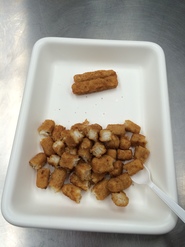
Looking
to add some variety to your menus? USDA
Foods added a new product that helps expand the options in the fish category
and is versatile to meet a variety of menu needs. Item 110851 is made with once-frozen, deep-skinned Alaska pollock fillets with a
whole grain breading. The fish is the same high quality Alaska pollock as
in the USDA pollock available for further processing, but one additional
processing step is added. When the skin is removed from the fillets, they are
cut a bit deeper to remove the darker fat line to give the fish sticks a white,
flaky interior. This product can be
served as a fish stick or used in fish tacos, as a topper for a rice bowl, or
in a wrap. For more recipe ideas and photos, check
out the Genuine Alaska Pollock recipe page.
|
EAT YOUR VEGETABLES! Remember your
parents saying that at the dinner table? Here at USDA, we feel it is
good advice! In fact, we are continuously looking for more types of
vegetables to
offer as USDA Foods in the National
School Lunch Program (NSLP) to encourage children to eat their veggies. Many different
types of vegetables and new package sizes have been added to the Foods
Available List (FAL) to accommodate school needs.
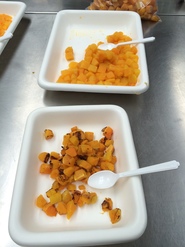
The current school
meal patterns require each vegetable subgroup to be offered weekly. On the
FAL, USDA has identified each vegetable offered in the proper
subgroup. Since 2015, three new vegetable options – crinkle cut sweet
potato fries, sweet potato chunks, and butternut squash – have been added to
the red/orange vegetable
subgroup. In addition, diced carrots are now available in a
smaller package size conducive to batch cooking, and our low-sodium spaghetti
sauce saw some improvements to its spice profile to increase consistency
between vendors. The butternut squash (pictured on the right, both uncooked and
roasted) is a new product for School Year (SY) 17-18. The product is available
for deliveries from November 2017 through June 2018. It is not available at the
beginning of the school year because it is harvested in the fall. It has
already proven to be desirable – over 1 million pounds have been
ordered for that timeframe!
|
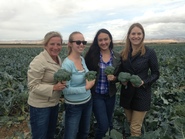 In January 2013, USDA
began offering frozen broccoli florets for the dark green vegetable subgroup. For SY
15-16, the broccoli florets package changed from a 6/5 pound case to a 30-pound
case to meet the commercial standards. Changing the specifications to
align with industry’s packaging practices enabled USDA to meet the order
demands of over 10 million pounds a year. Pictured on the left are
USDA staff visiting a USDA vendor's broccoli field in 2015. The dark green
vegetable subgroup also includes both a 12/2 pound and 20-pound package of
frozen chopped spinach. The ‘other’
vegetable subgroup includes a recently added pepper/onion blend
that has since become an attractive and versatile addition to NSLP menus. First
offered for SY 16-17, USDA purchased a little over 1 million pounds for
deliveries made between September 2016 and January 2017. Orders doubled
for SY 17-18, totaling over 2 million pounds.
|
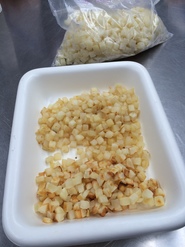
The starchy vegetable subgroup
includes a new 12/2.5 pound package of peas to accommodate smaller districts’ needs,
and the SY 17-18 FAL includes a diced potato item (pictured on the right)
for this vegetable subgroup. This product was available for ordering for
October 2017 through June 2018 delivery, with over 1 million pounds ordered for
that timeframe.
These new products and new packaging options
resulted from feedback received from our stakeholders. If you have a
product you would like USDA to consider, please review the
resource “USDA Foods: How to Get Your Product Considered” and contact us at USDAFoods@fns.usda.gov. We love to
hear new ideas, but until then, don’t forget to EAT YOUR VEGETABLES!!
|
Curious where your USDA Foods come from? The "State of Origin for USDA Foods in Fiscal Year 2015" report is now available! This report analyzes State-of-origin data for fiscal year (FY) 2015, which captures the States where USDA purchased food. In FY 2015, USDA purchased over 2 billion pounds of food, at a cost of nearly $2 billion. This included both raw food products such as meats, vegetables, and fruits; products used as ingredients in further processed foods; as well as finished food products like cereal, crackers, and pasta.
Check out the full report for more interesting statistics. For example, "The five States with the highest dollar values for foods originating from a State were California, Minnesota, Pennsylvania, Illinois, and Michigan. On a per-capita basis, the three States with the highest dollar value of USDA Foods originating from a State were Alaska, Minnesota, and New Mexico."
The map depicts the states that supply the largest quantities of each USDA Foods product category. There are two food category icons on the map for each USDA Foods category, indicating the two states of origin with the greatest dollar value of USDA purchases for that food category.
Team Nutrition is rolling out new standardized recipes for schools and Child and Adult Care Food Program (CACFP) audiences. Check out the USDA Standardized Recipes page for culinary inspiration to add to your menu!
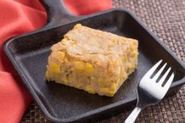 USDA’s newly standardized recipes provide Child Nutrition Program operators with delicious new dishes that help them meet meal pattern requirements. These recipes have been standardized to provide updated crediting information that includes the vegetable subgroups. The new recipes also include kid-approved recipes that use at least one of the following ingredients: legumes, whole grains, dark green vegetables, or red/orange vegetables.
Here are links to ten standardized recipes that use USDA Foods. Each recipe has a version for CACFP (25-50 servings) and schools (50-100 servings).
|
During
the summer of 2016, eight states participated in a pilot to use Summer Food Service Program (SFSP) USDA Foods
dollars to buy fresh fruits and vegetables through the USDA DoD Fresh Fruit and
Vegetable Program. To ensure successful participation in and management of the
pilot, USDA has developed best practices to assist State Agencies, SFSP
Sponsors, and SFSP sites in making the best use of their resources and providing
healthy options to SFSP participants.
Best Practices for
using USDA DoD Fresh in the SFSP:
- Work with
sponsors already utilizing USDA DoD Fresh in the National School Lunch Program
(NSLP)
- Coordinate
outreach and training early for SFSP sponsors interested in participating,
ideally starting in January
- Provide
training for SFSP sponsors on program operations, how to use FFAVORS, and eAuthentication access
- Provide
effective oversight of pilot program throughout the summer
- Have
sponsors begin placing orders for USDA DoD Fresh produce as soon as SFSP starts
- Work
closely with the Food and Nutrition Service (FNS), the designated Defense Logistics Agency (DLA) Field Representative, and the USDA DoD
Fresh produce vendor
- Let
the produce vendor know if you are interested in the availability of local
produce
This
pilot provides an effective way to utilize USDA Foods summer dollars. Benefits to States
can include easier planning, lower food costs, and reduced storage fees. Additionally, program participants have
continued access to high quality fresh fruits and vegetables during the summer
months when schools are not in session, thus increasing the value of summer
meals. Due to the success of the pilot, it has been expanded to include five
additional states this summer.
A
recording of the “Best Practices for the Use of the USDA DoD Fresh Program in
the Summer Food Service Program” webinar is available on YouTube! Click here to view the video.
Please
contact Blair Tucker-Gruchala at Blair.Tucker-Gruchala@fns.usda.gov or Janet West at Janet.West@fns.usda.gov for further details about this pilot.
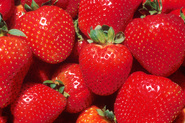 During this school year, USDA received feedback from State Distributing Agencies concerning the sugar content found in the USDA Foods strawberry cups. USDA Foods offers a variety of frozen strawberry products: some are Individually Quick Frozen (IQF) and are unsweetened, and some have a small amount of sweetener added to help maintain the flavor, color, and texture of the food in the form provided (e.g. individual portion cups). USDA worked with its vendors to offer product with the lowest possible sugar levels, while maintaining the product quality. This led to a product with nearly half the total sugar level of similar commercial products (17 grams versus 31 grams per ½ cup serving). This school year, USDA Foods also added a new unsweetened IQF sliced strawberry product to offer additional options for schools to choose from.
As a reminder, it is important to submit a complaint whenever a product received does not meet the customers’ expectations. The goals of the USDA Foods Complaint Team are to provide responsive customer service, investigate and resolve complaints/issues, provide guidance and training on how to handle USDA Foods, and collaborate with the Agricultural Marketing Service (AMS) to resolve issues with vendors. By submitting a complaint through the Web-Based Supply Chain Management (WBSCM) System, our team is able to use that information to identify national trends. We ask you to “inspect what you expect” when it comes to USDA Foods.
For more information on how to file a USDA Foods Complaint, review How to File a USDA Foods Complaint.
To better serve customers, additional communication channels assist in complaint resolution. The Complaint Team is available Monday-Friday, 6:00 a.m. – 5:00 p.m. Eastern Time. Email USDAFoodsComplaints@fns.usda.gov or call the USDA Foods Complaint Hotline at 800-446-6991.
|
 |
Laura Castro, FNS Food Distribution Division Director; Dave Tuckwiller, AMS Commodity Procurement Director; and Laura Carroll, FNS Child Nutrition Programs Nutritionist, provide updates during the USDA General Session at ACDA.
The American Commodity Distribution Association (ACDA) annual national conference held in Denver, Colorado last April was a great
opportunity for USDA to interact with nearly 700 of our partners from State
agencies, industry, school districts, and food banks. Throughout the conference, USDA had the
opportunity to present on a variety of topics such as the Business Management
Improvement effort, inventory management, new USDA Foods, the USDA DoD Fresh
program, and updates for household programs. But, more importantly, staff was able to hear best
practices from State agencies, industry partners, and recipient agencies about
how to effectively use and manage USDA Foods. USDA looks forward to other opportunities to
interact with stakeholders at meetings and conferences in the future. To view the conference presentations (available to ACDA members with login), click here.
WBSCM Email Communications
Updates about Web-Based Supply Chain Management (WBSCM) system availability, new and enhanced
features, and important reminders are shared via the “News and Announcements”
forums on the Home page and the new notification banner. Users can “watch”
a forum to receive updates when new information is posted. Additionally, some
critical and/or time-sensitive announcements are shared directly by email to
reach all impacted users--especially those who may not log in to WBSCM frequently.
A new email address has been set up for WBSCM announcements.
Users are encouraged to add WBSCMcommunications@caci.com
to their address book and/or Safe Senders list to prevent this important news
from being blocked by their email server. Please note this address will be used
for outbound messages only and will not be monitored. Questions about WBSCM
should be directed to the WBSCM
Service Desk.
Customizing WBSCM Reports
General guidance about working with reports is available in
WBSCM at Help -> Training Materials
-> Job Aids -> Reports (JA) -> Reporting Navigation. WBSCM
standard reports provide flexibility with both content and format to meet the
needs of different user groups, food distribution programs, and data requests. Most
reports also include an option to export the output to Excel, which offers
additional tools for organizing and analyzing data.
If the same search criteria will be used in the future, they
can be saved as a variant. To view
options to load, save, or delete variants, first click the Show Variants link to expand dialog box. In the following example,
the user has saved a variant “SY2016-17” with the search criteria to monitor
the requisition status for all materials requested for delivery to the specified
Ship-To during the 2016-2017 school year for NSLP.
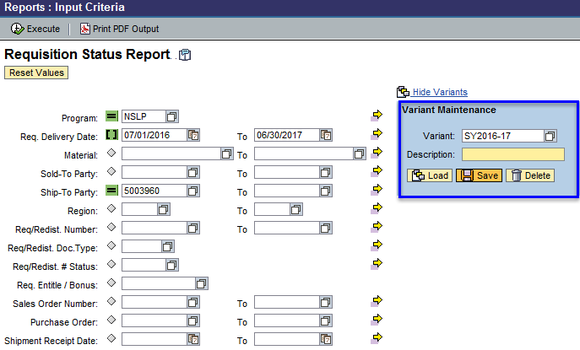 |
If a particular layout will be used again, the user can save
this custom view and easily access
the same settings later. Users may format the report to their liking by adding
or removing columns for some data fields, modifying the sequence of columns,
changing sort order, and more. In the following example, the user has removed
some of the default fields, changed the column order, grouped and sorted by Sold-To
and requested delivery date. Because they want to use the same layout when
running this type of report in the future, the user has saved these settings as
“My Custom View.”
Hands-On Practice with WBSCM
The WBSCM
training environment (NTRN) provides sample data and a safe setting for
hands-on practice for most transactions. For the most part, email notifications
and interfaces with external system are disabled. While practicing, users can
assure themselves that they are working in NTRN (and not the “live” Production
environment) by referring to the logo in the upper right corner of the screen:
Each month, NTRN is updated to the most current WBSCM
software release. Each week, the sample data is restored to the original copy,
and any changes made since the last restore will be lost. NTRN is not available
during the weekly maintenance window from Noon on Friday to Noon on Monday.
To request access to NTRN, contact the WBSCM Service Desk.
 Here's how to sign up for these updates via GovDelivery:
1. Go to the Food Distribution website.
2. Click on the red envelope on the row of social media icons on the top right of the page.
3. Enter your email address and click "Submit."
4. Check the boxes to select your topics of interest. For these e-letters, scroll down to the Food Distribution category and click the plus sign to the left of the check box to expand the list and view all the sub-categories. Check these sub-categories to receive the corresponding e-letters:
*USDA Foods --> receive all "USDA Foods from Farm to Plate" general + program-specific e-letters
*Commodity Supplemental Food Program (CSFP) --> receive "Household Highlights" e-letter
*The Emergency Food Assistance Program (TEFAP) --> receive "Household Highlights" e-letter
*Food Distribution Program on Indian Reservations (FDPIR) --> receive "FDPIR Connection" e-letter
*Schools/Child Nutrition Commodity Programs --> receive "Spotlight on Schools" e-letter
5. Update your subscription preferences any time by following the above steps or clicking on the Subscriber Preferences Page link at the bottom of any of the e-letter email messages you receive from GovDelivery. Questions? Contact us at USDAFoods@fns.usda.gov
|
|